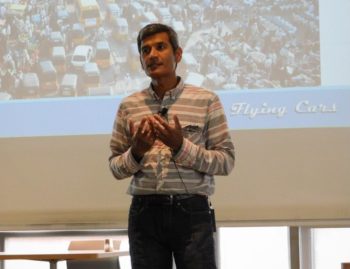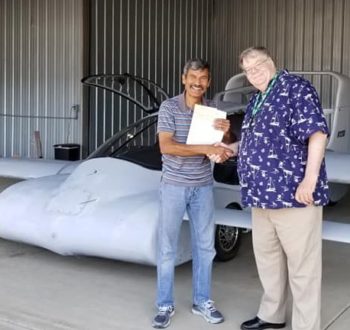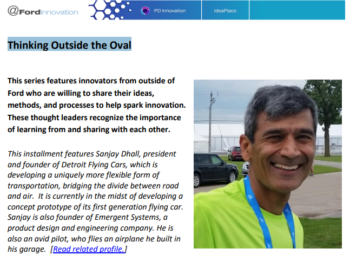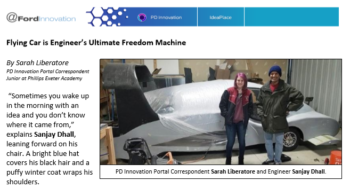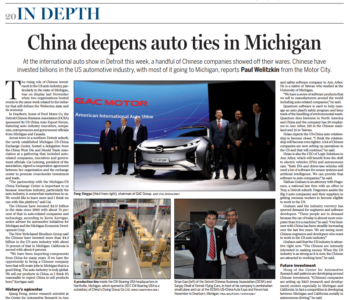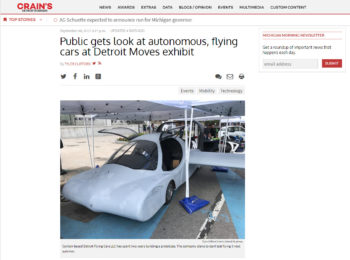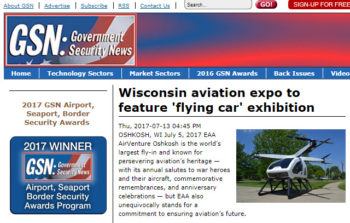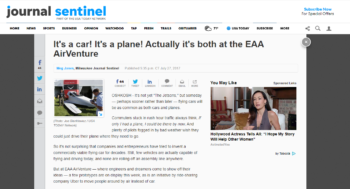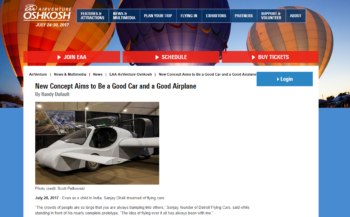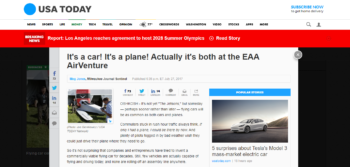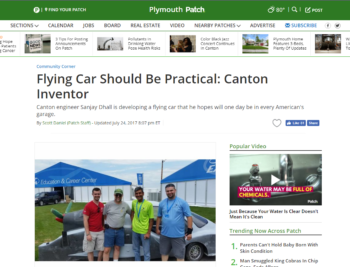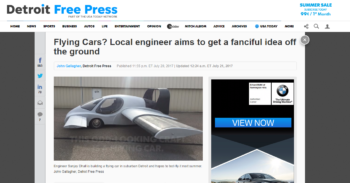Status Update After the December 14, 2018 Incident
On December 14, 2018 a routine high-speed taxi test of the WD-1 concept prototype turned into an accident. This taxi test was one of many. Winds were light and out of the west at a mild 5 knots. After successfully taxi testing the front suspension through this test today, an additional ballast of 50lbs is to be added at the nose for proper balance and location of center of gravity for the vehicle.
We had someone on the field to help video record the first WD-1 high speed taxi test. Taxi test #1 was into the wind and went off without a hitch. The newly modified front suspension system was performing well, and the steering was responsive. The machine easily accelerated to the estimated take off speed of 60 mph. The joystick controls appeared to respond appropriately. Taxi #2 was with the wind, and vehicle behaved predictably again. On taxi #3, I accelerated to a little over 60 mph, and continued testing joystick forces. Perhaps I was a little more aggressive with joystick as I pulled back once more.
The vehicle took off unexpectedly and climbed about 100 feet into the air. Without the nose weight that was to be added, the nose pitched up more easily, the vehicle stalled and descended back to the ground. The vehicle prototype and I both suffered damage from the impact. Despite the accidental take off that damaged the machine and injured me, we learned a lot about the vehicle design from this accident. Here’s what we learned:
- WD-1 is easily capable of flight! It took off easily.
- The powerplant makes abundant thrust for flight.
- The structural design is robust. It took an impact at ~60mph at a 45° nose down angle, and pilot survived!
- The machine showed no undesirable roll tendency due to the unsymmetrical flying surface configuration.
This accident was the result of an error of judgement on my part. No taxi testing should ever be undertaken without setting the C.G. in the appropriate zone. And cost the project a setback of time. Nonetheless, development work will continue. Planning has begun to repair and rebuild this prototype, as well as to build other prototypes of various scales for further testing.
Flying Car Pioneer Preaches Different Ways of Thinking
From looking outside where the answers seem to lie and being open to learning from unexpected sources, finding new ways of thinking is a key philosophy that has guided a pioneer in vehicular aviation. Sanjay Dhall, co-founder of Detroit Flying Cars and a former Ford employee, spoke at a recent innovation talk hosted by the Vehicle Component & Systems Engineering innovation acceleration team in the Product Development Center cafeteria.
@FordInnovation
The FAA granted Detroit Flying Cars the Special Airworthiness Certificate to the flying car prototype on Thursday, July 19, 2018. Although the Detroit Flying Car team will be approaching the flight test cautiously, Detroit Flying Cars can now start testing its flying characteristics.
@DetroitFlyingCars
Thinking Outside the Oval
This installment features Sanjay Dhall, president and founder of Detroit Flying Cars, which is developing a uniquely more flexible form of transportation, bridging the divide between road and air. It is currently in the midst of developing a concept prototype of its first generation flying car. Sanjay is also founder of Emergent Systems, a product design and engineering company. He is also an avid pilot, who flies an airplane he built in his garage.
@FordInnovation
“Sometimes you wake up in the morning with an idea and you don’t know where it came from,” explains Sanjay Dhall, leaning forward on his chair. A bright blue hat covers his black hair and a puffy winter coat wraps his shoulders…
By Sarah Liberatore – PD Innovation Portal Correspondent Junior at Phillips Exeter Academy
Like Henry Ford who toiled in a Detroit garage more than 100 years ago to bring an invention called the automobile to the masses, Sanjay Dhall labors in a Motor City area airport hangar in the quest for his invention: a combination car/plane.
“I am making this for me. I want to build a machine that I can drive out of my garage and then fly me to wherever I want to go,” he said at the US China Auto Expo and Forum 2017 sponsored by the Detroit Chinese Business Association in November.
BY PAUL WELITZKIN ON SEPTEMBER 18, 2017
The aviation industry’s interest in the concept of cars that can fly (or rather, planes that can ride the roads) dates back at least to the early 1950s. The Experimental Aircraft Assn.’s (EAA) AirVenture airshow, known back then as the Oshkosh Fly-In, was often the stage for unveiling flying car prototypes.
At the 2017 event (Oshkosh, WI, US; July 24-30), there were several such unveilings.
Wings Over Detroit
Detroit Flying Cars hopes to have its WD-1 in the air by next year.
How will the WD-1 differ from other vehicles and concepts that have been dubbed “flying cars”? Detroit Flying Cars founder Sanjay Dhall, the person who designed and is building the WD-1 prototype in a hangar at Canton-Plymouth Mettetal Airport in Canton, Mich., says that some of those machines don’t fly like planes and others don’t drive like cars, but his will do both.
BY LARRY BEAN ON SEPTEMBER 18, 2017
The future of mobility is on display in downtown Detroit, with live demonstrations at the Detroit Moves exhibit sponsored by Quicken Loans Inc.
The event, which runs through Sunday, will showcase innovative mobility technology that is being created in Michigan, coinciding with the Technology in Motion conference presented by Detroit-based Crain Communications Inc. and Detroit-based MSX International Inc.
The outdoor exposition is taking place at the Spirit of Detroit Plaza, Campus Martius and Woodward Avenue Esplanade. The free public event also features art, music and food trucks.
EAA AirVenture Oshkosh is the world’s largest fly-in and known for persevering aviation’s heritage — with its annual salutes to war heroes and their aircraft, commemorative remembrances, and anniversary celebrations — but EAA also unequivocally stands for a commitment to ensuring aviation’s future.
That’s why every year, aviation innovation is encouraged and showcased and 2017 will be no exception when The World’s Great Aviation Celebration comes to Wittman Regional Airport in Oshkosh, Wisconsin on July 24-30. The event, which annually welcomes an attendance of 500,000 along with 10,000 aircraft, is also the 65th annual fly-in convention for the Experimental Aircraft Association.
A handful of designs already are undergoing testing, while a number of others are set to take to the air over the next few years. Concerns over technology and high costs could affect the flying car market, yet analysts appear to be optimistic about its success.
“Usually, the best indicator for how far away things are is when you start to see people testing them in real-life situations around the world,” says Jono Anderson, principal-strategy and innovation for consultancy KPMG.
“The biggest challenge is the fact that one has to build the right vehicle, and the ones out there are not right yet,” says Mathias Entenmann, Berlin-based partner at consultant BCG Digital Ventures.
Remi Murrey | WardsAuto
Ultimately, flying cars, just like road vehicles, are expected to operate autonomously, which presents another technical hurdle for developers and further complicates the regulatory picture.
“I think at low-altitude capability and with the kinds of autonomous controls people are talking about, yes, there will be challenges getting the right regulations in place, but it should be achievable,” says Thomas Mayor, national partner-U.S. Aerospace and Industrial Markets Strategy for KPMG.
Remi Murrey | WardsAuto
OSHKOSH – It’s not yet “The Jetsons,” but someday — perhaps sooner rather than later — flying cars will be as common as both cars and planes.
Commuters stuck in rush hour traffic always think, If only I had a plane, I could be there by now. And plenty of pilots fogged in by bad weather wish they could just drive their plane where they need to go.
Meg Jones, Milwaukee Journal Sentinel | Published 5:35 p.m. CT July 27, 2017
Even as a child in India, Sanjay Dhall dreamed of flying cars.
“The crowds of people are so large that you are always bumping into others,” Sanjay, founder of Detroit Flying Cars, said while standing in front of his nearly complete prototype. “The idea of flying over it all has always been with me.”
By Randy Dufault | July 28, 2017
The Experimental Aircraft Assn.’s (EAA) annual AirVenture air show features some of the world’s most advanced, futuristic and obscure aircraft and technologies in the aviation industry. 2017 was no different, with several manufacturers unveiling new autopilots, low-cost ADS-B hardware and new flying cars, among other things.
Here are 10 new aircraft, avionics and flying cars that were unveiled at this year’s show.
By Staff Writer | July 31, 2017
OSHKOSH – It’s not yet “The Jetsons,” but someday — perhaps sooner rather than later — flying cars will be as common as both cars and planes.
Commuters stuck in rush hour traffic always think, If only I had a plane, I could be there by now. And plenty of pilots fogged in by bad weather wish they could just drive their plane where they need to go.
Meg Jones, Milwaukee Journal Sentinel | Published 6:35 p.m. ET July 27, 2017
The concept features a unique configuration, with telescoping and offset wings combined with a telescoping canard and powered by a pusher propeller driven by an aviation engine in flight and battery-powered electric motors on the ground.
The unfinished prototype on display at Airventure reveals a clear automotive bias, with the wheel-base and stance of a sports car, gull-wing doors and steering wheel controls.
That appearance is no accident. Detroit Flying Cars was founded by engineer Sanjay Dhall, who runs a company supplying components to automotive manufacturers.
26 JULY, 2017 | SOURCE: FLIGHTGLOBAL.COM | BY: STEPHEN TRIMBLE
Canton engineer Sanjay Dhall is developing a flying car that he hopes will one day be in every American’s garage.
CANTON, MI — What do Uber, Toyota, Airbus, Google, Skype and Canton resident Sanjay Dhall have in common? All are working on flying cars that may start transforming everything from personal mobility and recreation to business and militaries around the globe as soon as the end of this year.
“The crowds in India drove me nuts,” he said this week at the Canton–Plymouth Mettetal Airport. “If you grow up in India you’re bumping into people all the time. So I always wanted to get away and fly over it all. Part of the reason for coming to the United States was the open spaces here. The ability to fly over this stuff has always driven me.”
John Gallagher, Detroit Free Press | Published 11:55 p.m. ET July 20, 2017
The latest flying machines, including drones, helicopters, flying car concepts, and more will be part of the 65th annual Experimental Aircraft Association fly-in convention July 24-30 at Oshkosh, Wisconsin. The world’s largest fly-in annually draws 10,000 airplanes to Wisconsin and a total attendance exceeding 500,000.
OSHKOSH, WISCONSIN (PRWEB) JULY 05, 2017

